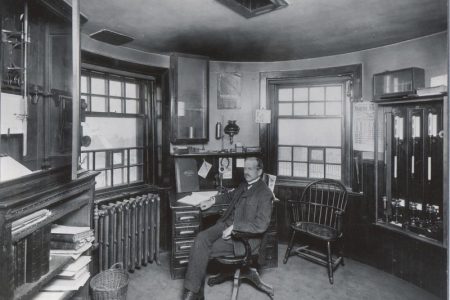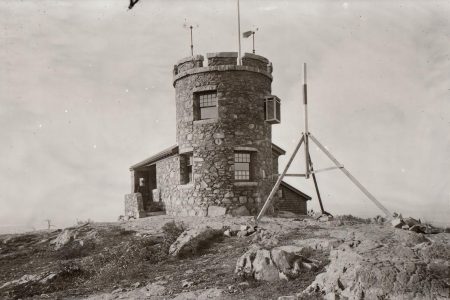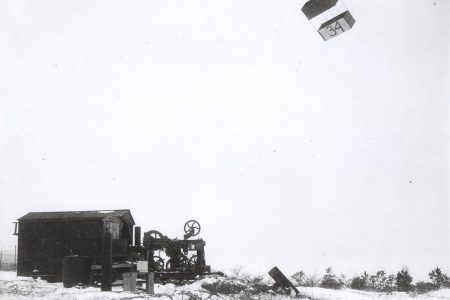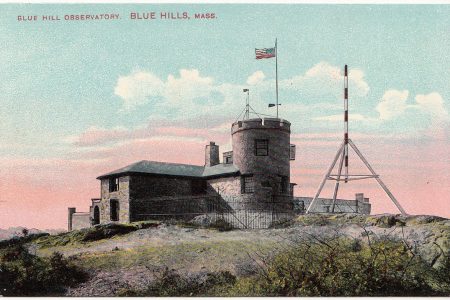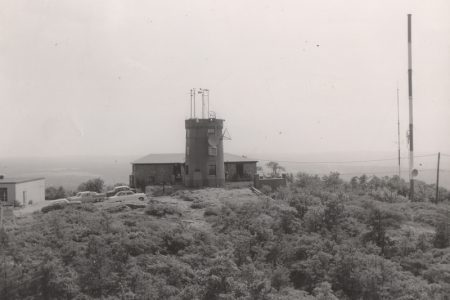About Blue Hill Observatory
Since 1885, the historic Blue Hill Observatory has maintained an extensive and high-quality record of local climate and has supported pioneering research in atmospheric science. This focus was expanded in 1998 when the non-profit Blue Hill Observatory & Science Center was established to support public education of climate and Earth science.
Our Mission
Our mission is to foster public understanding of Earth’s weather, climate and environmental systems and to continue to produce, maintain, and analyze a meticulous, consistent record of weather and climate observations.
Our Vision
We envision a world where the health and well-being of all people and the planet are protected and promoted through Earth system science research, education, and outreach.
Centennial Observing Station
In May 2017, the Blue Hill Observatory was one of the first sites in the United States to be selected as a Centennial Observing Station by the World Meteorological Organization in recognition of its long and high quality climate record and the need to preserve and to maintain long-term surface observing stations for their important role in the continuing study of climate.
WMO Centennial Observing Stations
National Historic Landmark
The Blue Hill Meteorological Observatory was designated a National Historic Landmark by the National Park Service on December 20, 1989 due to its significance in commemorating the history of the United States through its pioneering contributions to the development of meteorology.
Our History
A Brief History of the Blue Hill Meteorological Observatory
Celebrating Over 130 Years: 1885 – Present
The Blue Hill Observatory was conceived and constructed by Abbott Lawrence Rotch when he was 25 years of age. This fascinating man, born during the start of the Civil War in April 1861, was the seventh child of a prominent Boston family whose roots went back to Nantucket and New Bedford whaling and shipping interests in the 18th century. Joseph Rotch, Abbott’s great-great-grandfather, owned the ship Dartmouth, which was involved in the Boston Tea Party in 1773, and his son William built the warehouse that became the Pacific Club, which still anchors Main Street in Nantucket.
Rotch’s first interest in the weather is not known, but he began to keep a small diary of the weather in 1878 at his Boston residence on Commonwealth Avenue. This diary revealed that he was a proficient observer. He graduated from MIT with a degree in engineering in 1884 with financial security, since he had inherited funds on his father’s death in 1882. This allowed him to pursue his interests in the weather while providing for his family and other public service interests. Soon after graduation, he began to conceive of a private observatory to carry on his growing interest in the weather. After purchasing a plot of land at the top of Great Blue Hill, near the family’s summer home in Milton, he began to plan construction with the help of his brother, Arthur, who was an architect with the firm Rotch and Tilden.
At the cost of $3500, Rotch constructed a small, stone tower Observatory with the living quarters in Canton and the tower in Milton, since thebho1885 north view town line bisects the summit of the hill. At midnight on 31 January 1885 fireworks were set off, and Rotch commenced a weather observational program that has continued uninterrupted to the present day. Thus began the oldest, continuously operated weather Observatory in the United States – now both an International Benchmark Climate Station and a National Historic Landmark.
The first year of operation was fraught with endless difficulties ranging from leaks in the walls, freezing indoor temperatures, and frequent instrument failure due to the severe weather on the barren, windswept hilltop. All of these events, as well as detailed weather data from each day, were meticulously recorded in the hand of William P. Gerrish, Chief Observer for the first year. Rotch (in photo at left seated at his desk in the Observatory) soon became world-renowned in the field of meteorology as he met with European and American meteorologists and embarked on the systematic acquisition of meteorological books and data. His annual trips to Europe provided his new Observatory with the best complement of recording instruments in the Western Hemisphere.
Henry Helm Clayton, age 24, arrived in 1886 to replace Gerrish. Clayton was already interested in clouds and soon started recording their amount and type each hour. He was also interested in forecasting and modifying the Signal Service forecasts that Rotch had arranged to receive by telephone and transmit by means of “Weather Flags” from the top of the tower. A year later, Clayton brought Sterling P. Fergusson, age 19, to the hill. Fergusson was a mechanical genius and soon had the instrument problems under control. Under the guidance of Rotch, Clayton and Fergusson made an excellent team. By 1890, the first detailed cloud statistics in America were being accumulated. These observations provided the first basic climatology of cloud type, height and velocity in the Western Hemisphere.
In July 1894, William Eddy, a New York journalist, came to Blue Hill to show how his kites could lift instruments. On 4 August 1894, a series of five Malay kites make by Eddy lifted a special light-weight thermograph constructed by Fergusson to a height of 1,400 feet above the ground at Blue Hill. This marked the beginning of worldwide soundings of pressure, temperature, humidity and sometimes wind speed. Thereafter, the work advanced rapidly, reaching a peak of activity in 1896, when 86 soundings were made. A maximum height of 15,793 feet above sea level was reached in 1900. Some flights were made by alternately reeling in and out to sound vertically for periods of 24 or 36 hours, thus sampling upper air changes with time. Other flights were made near thunderstorms, and in rain and snowstorms. The work was extremely arduous, especially when breakaways occurred, which required a search for the kites and meteorograph and for retrieval of long lengths of brass piano wire used to fly the kites. One near disastrous flight saw a significant electric charge come down the kite wire and shock several kite attendants.
Rotch improved the Observatory structure three times. In 1889 the east wing was added to make a library and fireproof vault upstairs, with a shop and bedroom below. In 1902, the west wing and bedrooms were added. This housed the “new” library with an arched, Guastavino tiled ceiling upstairs and storage for kites downstairs. Also added to the room in the corners just below the ceiling were eight bas-reliefs representing the allegorical figures of the winds that were on the 1st century B.C. Tower of the Winds in Athens, Greece (“Zephyros” or zephyr, the west wind, is depicted at right). In 1908, the original two-story stone tower was torn down and replaced by the present three-story concrete tower, which was one of the earliest steel-reinforced concrete structures erected in this country. A stone wall and a gated, iron fence were added around the building in 1905.
Rotch died suddenly on 7 April 1912 after an undiagnosed, ruptured appendix. Letters of condolence poured in from Europe and America. According to his wishes, the Observatory was bequeathed to Harvard University with $50,000 to be set up in an endowment fund to operate the facility. Six years earlier, Rotch had been named the first Professor of Meteorology at Harvard.
On 1 October 1912, Alexander McAdie was appointed professor of meteorology and Director of the Observatory. He would serve as director for the next 18 years. McAdie was a kind, witty, and articulate man. His personal charm played an important role in raising $170,000 for endowment, an outstanding service to the Observatory. He had a penchant for writing, and while some of his work was purely philosophical, some brilliant reasoning in regard to cloud physics and supercooled water vapor appeared in his writings from time to time.
During the 1930’s through 1950’s, the Observatory became known around the world for its contributions to research and writing in the field of meteorology. This was the period of time when Dr. Charles Franklin Brooks was both Director of the Blue Hill Observatory and Secretary of the American Meteorological Society. Brooks was also a co-founder of the AMS in 1919. Under his leadership, the Observatory was the headquarters of the AMS, and the library grew to an estimated 25,000 volumes. Scores of research projects and studies were conducted and numerous papers were published during this time.
One of the most significant developments occurred during 1935-1936 when balloons were used to carry weather instruments into the upper atmosphere. During this time the first successful radio-meteorograph flight was made, and this pioneered
the development of the radiosonde in the United States.
In 1932, Brooks supplied instrumentation and observer training for the new Mount Washington Observatory, which marked the start of a long-time close association with Blue Hill. Radio transmission experiments at ultrashort wavelengths followed, and soon regular communication by radio was established between the Observatories.
In 1954, the first of a series of contracts was signed with the U.S. Air Force for the study of clouds and precipitation, and a weather radar facility was installed on the summit of Great Blue Hill. When Brooks retired in September 1957, long-time weather observer John H. Conover served as acting director until Richard M. Goody became director in July 1958. A year later, the Blue Hill observational program was taken over, on a diminished scale, by the United States Weather Bureau.
Under the directorship of Goody, the work of the Observatory was to change to studies of the high atmosphere, so the intervening period was used to wind down all activities. The library was dismantled and transferred to Harvard, the Observatory was remodeled, and a new mechanic shop was set up. Pioneering work on the upper atmosphere and airglow was carried out with Dr. John Noxon.
Although research and numerous studies continued through the 1960’s, the long-time affiliation with Harvard came to an end in 1971. At that point, the Observatory was turned over to the Massachusetts Metropolitan District Commission, which maintained the state park on which the Observatory was located, and the site was scheduled to be discontinued as a National Weather Service observing station. Fortunately, through the efforts of several loyal supporters, the National Weather Service’s decision was reversed, and the observations under contract from the NWS were continued.
In 1981, under the direction of Dr. William E. Minsinger, the Blue Hill Observatory Weather Club was formed, and since that time an uncompromising effort has been made to save the building and to restore it to its former glory. Interim repairs were made in 1985 for the Centennial Celebration, during which the Rotch memorial monument on the summit was etched with a summary of the weather records from the first one-hundred years. In 1989, the Observatory was declared a National Historic Landmark by the National Park Service. Other officers of the not-for-profit at that time were John Anderson, Dave Doe, and Bob Skilling, who had started part-time work at Blue Hill in 1960 and became Chief Observer in 1978 (a position he held continuously until 2014). Justin Barton acted as a legal adviser. Christopher Tingus of Milton played a key role in publicity with regards to the Annual Blue Hill Observatory Hurricane Tracking chart, reaching out to radio stations and TV meteorologists across the country and even Bermuda – well over 500,000 charts were distributed and membership reached 1200 in these years. Thanks to corporate sponsors such as the Foxboro Company, the charts were distributed free to anyone who sent in a self addressed stamp envelope.
An extensive renovation of the facility was completed in 1999, and that spring the non-profit Blue Hill Observatory Science Center was established to expand the mission of the Observatory to focus on increasing public understanding of, and appreciation for atmospheric science. At this time, William Minsinger became the President of the organization, and Charles Talcott Orloff became the Executive Director. In 2002, the Observatory was recognized by the American Meteorological Society with its Award for Outstanding Services to Meteorology by a Corporation for its historic climate record and its many contributions to weather research and education. In 2017, the Observatory was among the first group of stations from around the world to be recognized as a Centennial Observing Station by the World Meteorological Organization. Today, the Observatory, its staff and many volunteers remain committed to its mission “to foster public understanding and appreciation for atmospheric science, while continuing to maintain a meticulous record of weather observations for the long-term study of climate”.
Portions of this history and chronology were compiled from: The Blue Hill Meteorological Observatory: The First 100 Years, 1885-1985, by John H. Conover, published by the American Meteorological Society, 1990.
Our Location
The Blue Hill Observatory is located at the summit of Great Blue Hill on the Blue Hills Reservation at the junction of Routes 93 and 138 about 10 miles south of Boston in Milton, Massachusetts. The closest parking is at the Blue Hill Ski Area or the adjacent Trailside Museum at 1902 Canton Avenue in Milton, MA. Hiking trails lead to the summit from these parking areas. The summit access road is not open to public vehicles; the walk up the hill to the Observatory along the summit road is approximately one mile. Click here for trail maps and information.
Membership & Support
Become a member to learn about climate, receive free tours of the Observatory, get discounts in our gift shop, enjoy our programs, and to support our important mission.



